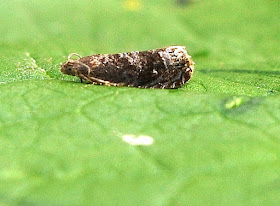Today, with Coleophora glaucicoella (kindly dissected by Graeme Smith) the total of 200 micros was achieved.Other micros that contributed to this total from yesterday and this morning were: Bryotropha terrella, Grapholita funebrana, Rhodophaea formosa and Rhopobota naevana (again, confirmed by GJS)
These helped take the total to a very pleasing 499 moth species for Little Hadham parish, records beginning in June 2011. Several outstanding micros still to identify should confirm the 500 mark. A pleasing achievement. Suspect finding the next 100 is going to take a while!
Also, a large twin-spotted carpet brought up the 150th macro for 2015, whilst the Bryotropha terrella meant 130 micros for the year, a pleasing 280 species for 2015 so far. Well on the way to beating last year's total of 331 species for the whole of 2014 and this is after a disasterous start, where moths were few and far between and many early spring macros failed to get to the trap due to cold nights courtesy of a constant northerly air movement.
Just to round off the statistics, a common footman was my 2000th moth for the year, with the total now increased to 2089 due to taking 83 moths last night of 52 species. Think that is enough statistics for one blog entry. Hopefully, tomorrow will be able to report what the 500th moth is.
The Rhodophaea formosa is indeed a good moth for Herts, with only 8 records up to 2006. I await to find if this has established itself back in Herts following its crash in numbers in the mid '70's. This fall has been attributed to the presence of Dutch Elm disease, that contributed to the demise of other elm creatures such as the white letter hairstreak, now making a pleasing return to most lepidopterists year lists.
Within the list of almost 500 moths are some seriously rare creatures as well as many local and with less than 10 county records. High on the list must be oncocera semirubella (taken at light trap 21.07.14)and Dichrorampha sequana, (taken 07.06.15) both having a status of Herts extinct before being refound. Also, with less than 4 county records at the time of finding are Jersey Tiger (17.08.12 and afterwards) Synaphe punctalis (04.07.15) Argyresthia cupressella (01.07.15) Diasemiopsis ramburalis (15.10.14) Diaphania perspectalis (07.08.14) Agriphila selasella (04.08.14) and several others. See list on right of blog.
Obviously, what is rare in Little Hadham may well be common elsewhere, Synaphe punctalis for instance. 2 records for Herts ever and likewise in Bedfordshire, 2 records, whilst Sean, a moth-er in Portland reports it is frequently the most common micro in his trap. Consequently, worth noting macros that I have only taken once or twice in the garden: Green silver lines, sprawler, dusky lemon sallow, treble bar, lobster moth, blackneck, bird's wing, small rivulet, small phoenix, pine beauty, chocolate tip, shark, oak nycteoline and deep brown dart. All the equivalent of coming across an osprey or hoopoe within the parish, or an aquatic warbler within Hertfordshire. Roll on the next 100 species! Edit: my suspected Spinolata laricana tunred out to be Spinolata ocellana, so back to 498 moths for the parish, so best I get out there and pot every micro that comes in range tonight!
 |
| Less common pattern on July Highflyer |
 |
| Rhodophaea formosa |
 |
| Another angle |
 |
| Final shot showing all the required features |
 |
| Grapholita funebrana |
 |
| Bryotropha terrella |
No comments:
Post a Comment